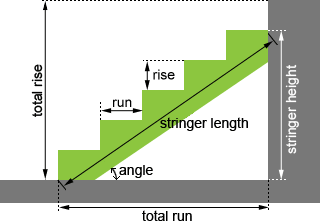Stair Calculator
Automated stair calculator to improve your construction skills. Select the complexity level and input the details to apply the stair calculation formula.
Basic Version

Comprehensive Version
Stair Calculation Results
Automated stair calculator to improve your construction skills. Select the complexity level and input the details to apply the stair calculation formula.

Stair Calculation Results
To assure perfection in the construction of stairs, François Blondel, a French architect, invented the Blondel formula. This stair calculation formula is considered a goldmine amongst architects. It guarantees a pleasant stride to most people by performing calculations according to the following equation:
2 Riser + 1 Tread = 25 inches (63-65 cm)
François Blondel also created a 1-Riser variation of the Blondel formula to handle diverse use cases. The following expression describes the details of that formula:
1 Riser + 1 Tread = 18 inches (46 cm)
These stair calculation formulae serve as the foundation for any effective stair-building project and are necessary to assess a staircase’s aesthetic and practical characteristics.
Apart from the Blondel formula, stair construction involves various other terminologies. Therefore, before beginning the stairs calculation, one should be familiar with those terminologies. Check out the terms used in the building of staircases:
Guards or guardrails are vertical or horizontal obstacles placed along the open sides of ramps or stairs to prevent falls. They are essential for staircases situated at high altitudes or in places where there is a chance of falling.
Handrails are rails that are positioned along the sides of a staircase to offer people support and direction. They are necessary for safety, especially when using stairs with several risers.
The part of the stairs that you walk on when going up or down is called the run or tread. The tread depth can be adjusted to offer varying degrees of comfort and safety. However, a typical tread depth is between 10 and 11 inches.
The vertical space above the stairs, measured from the tread to the ceiling or any higher obstruction, is known as headroom. Enough space must be considered while building headroom to prevent people from running the risk of knocking their heads on the steps.
Nosing is the part of the tread that curves around and goes past the riser. It improves the stairs' aesthetic appeal and increases their safety by reducing the risk of tripping.
Rise or riser refers to the vertical element that separates each tread. A constant riser height is essential to ensure both comfort and safety while using the stairs.
The width of the stairwell includes the breadth of the treads and guardrails or handrails. The rulebook specifies a minimum stair width to guarantee user safety, but it can vary depending on the expected amount of traffic and the planned purpose of the steps.
A stair stringer is a structural element that holds up the treads and risers. It is essential in giving the staircase stability and support. Stringers can be placed on the stairs or left exposed.
The computation of staircases can be overwhelming but our stairs calculator is here to save the day. This step calculation tool features a basic and advanced version to cater to the requirements of both beginners and professionals. Here is the step-by-step guide to using this stair calculator:
Get started by entering dimensions, like total rise and run.
Select whether your staircase has a ‘fixed rise (step height)’ or ‘fixed number of steps.’
Alternatively, enter the rise (step height) or number of steps.
Choose whether your staircase has tread or not.
Select whether your stair has a headroom restriction or not.
Select an option between ‘Standard stringer mount’ and ‘Flush stringer mount.’
Finally, hit the ‘Calculate’ button to instantly receive detailed calculations.
Hint: Use the ‘Clear’ button to erase the current values from the step calculator.
The inclusion of our deck: stair calculator :can make a big difference to your construction projects. Here is how:
Our developers have created this step calculator with simplicity in mind. With intuitive controls and easy-to-understand outcomes, this online tool can potentially serve users of all skill levels.
The user interface and experience of this deck stair calculator remain smooth and responsive on both mobile and desktop devices. Therefore, whether you’re in the comfort of your office or on-site, you can access this steps calculator anytime, anywhere.
The step calculator features a ‘Basic’ and ‘Comprehensive/Advanced’ version. This feature of our free steps calculator makes it beneficial for both beginners and professionals.
Our stair stringer calculator completely eliminates the need for guesswork. It operates on pre-trained accurate algorithms. Therefore, with this deck stair calculator under your belt, you won’t fall victim to costly errors.
Find answers to common questions about our free step calculator.